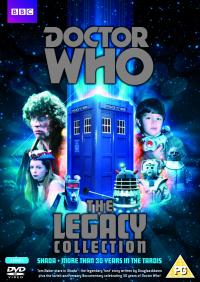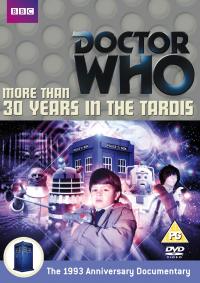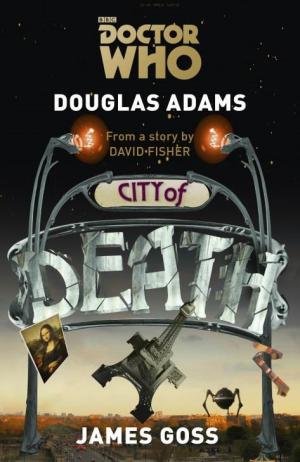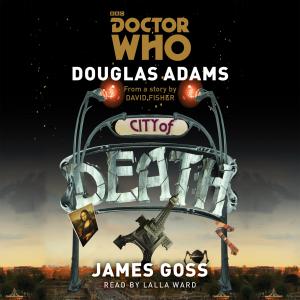 This review is based on a preview of the UK Region 2 DVD, which is released on 7th January 2013.
This review is based on a preview of the UK Region 2 DVD, which is released on 7th January 2013.Of all the DVDs in the classic series collection, this set has perhaps been the most divisive within fandom online before its release than any other. Without dragging this review into the quagmire, much of the discussion surrounds the presentation of the abandoned and never-broadcast
Tom Baker adventure
Shada and expectations over whether the unrecorded scenes would be 'completed' by animation or other means, and the resulting disappointment from some quarters when it was announced that it would 'simply' be based upon the edit produced for the VHS range in 1992.
Context is everything, though: is this a release of the story
Shada with other extras, or is this a collection of bits and pieces that includes
Shada?
Steve Roberts of the Restoration Team clarified:
The whole point of the 'Legacy' boxset is a mopping up exercise - it's mopping up Shada, MTTYITT and a few other extras that are left over at the end. That's all it was ever supposed to be!
In this context utilising the previous commercially available version in this set alongside
More Than Thirty Years makes sense; so, enough of what we didn't get, let's look at the wealth of material we do have in the set!
Disc One: Shada:

There are two versions of the story to choose from on the disc, the 'reconstruction' presentation of the original
Tom Baker material from 1979 that was produced by
John Nathan-Turner for VHS in 1992, and a revised animated version with
Paul McGann that was produced by
Big Finish in 2003 for the
BBC Doctor Who website. Being a classic series release, it isn't surprising that the primary version on the disc is the 1992 version, whilst space limitations mean that the animated version is consigned to watching on a computer - however, which is actually considered the 'better' presentation of the story will fall to personal taste!
Apart from the necessary adjustments to continuity to introduce why a different Doctor is involved, the main plot remains essentially the same in both. The Doctor answers a message from retired Time Lord Chronotis, now living at St Cedd's college in Cambridge, finding out that his old friend is actually in possession of a 'dangerous' book,
The Worshipful and Ancient Law of Gallifrey. However, Doctor Skagra of Think Tank is also after the book, knowing that its pages can reveal the way to the Time Lord prison planet of Shada where a criminal Salyavin has been incarcerated - Skagra wishes to obtain the latter's ability to project his mind into others in order to become the most powerful person in the universe. What ensues is a run around Cambridge and the galaxy as the Doctor, Romana and Chronotis with the aid of students Chris and Clare chase Skagra and his Krarg allies in order to thwart his plans.
And that's essentially it. To be honest there isn't much more to the story and the filmed scenes show that whilst the sparkle of
Douglas Adams dialogue is present, there isn't an awful lot of plot to fill the 1hr49m running time of the release, let alone a full six episodes' worth had the story been completed. Adams himself had said that he hadn't thought it very good (and cannibalised elements of the script for other works) - the story had only been released on VHS through him accidentally signing the paperwork.
It's the notoriety of the production that makes the story interesting, and this is documented quite thoroughly through both the production notes that accompany the episodes, and documentaries that can be found on the other discs in the set. Briefly, strikes were quite commonplace within the BBC in the 1970s, and
Doctor Who suffered three consecutive years of industrial action for the recording of season finales - 1979 was the year the production team's luck ran out and so
Shada was never able to recover the time needed to complete it, much to the chagrin of cast and crew. Nathan-Turner attempted to resurrect the story a number of times (including a potential
Colin Baker-narrated version in 1985), but in 1992 was able to convince BBC Enterprises that the story could be produced with new effects and linking narration from its star.
The ensuing release is a brave attempt to tell the story, but the lack of filmed material really becomes noticeable in the latter half the story, where much of the unrecorded studio material was destined. Chronotis's rooms, Skagra's ship brig, and Think Tank scenes were recorded, but TARDIS interiors, Skagra's and the Krarg's ship control rooms, and Shada itself were all lost. Though judicious use of new special effects help bridge some of the gaps, the latter episodes end up very heavily reliant on
Tom Baker's narration of what's happening "off-screen", and can lead viewers to wonder what is actually going on! Watching the animated version first can actually help a lot here as, with all the scenes 'present and correct', it means that when watching the original version it is possible to 'visualise' what is going on during those narrated moments.
One thing that grated in 1992 and still does in 2013 is the incidental music, which was written for the release by late 1980s resident composer
Keff McCulloch. I'm afraid I've never been a fan of his music in
Doctor Who, and the "tinkle tinkle" throughout
Shada is quite distracting at times. It's a shame JNT didn't secure
Dudley Simpson's services to provide a 'contemporary' score (and a shame the budget for the DVD couldn't stretch that far, either!). I also found K9's voice a little irritating too, but at least
David Brierley is contemporary (though
John Leeson's interpretation will always be definitive, and very welcome in the animated version).
A few observations on the VHS version:
- From the outset it feels like the story is being introduced by Professor Geoffrey Hoyt, as Tom struts around the old MOMI Museum Doctor Who exhibits in a suit straight out of Medics. His delivery is also quite OTT, though fortunately the actual narration is delivered in a matter-of-fact way (and as the Doctor).
- Watch out for Professor Chronotis's magic spectacles in episode two!
- The major plot point of needing Salyavin's mental agility is perhaps of less importance if you consider the Doctor demonstrated this ability with himselves in The Three Doctors, or more recently with Craig in The Lodger!
- The one genuine recorded effect of the two TARDISes in the vortex actually looks quite poor in comparison with the 1992 CGI ...
- ... though the "blocky" effects used in some places feel very dated!
- Nobody seems to know why Clare's hair changes from severe scientist bundle to a more feminine wavy loose style in episode five - maybe her shock at the sparking console had more of an effect on her than originally thought ...
- K9 seems to be back under the influence of the Shadow at one point, judging by the Danger, Doctor exclamations as Think Tank explodes.
- There was a proposal for romantic interest between Chris and Romana ... half-human on his father's side?!?!
- Christopher Neame spends way too much of his time resembling Julian Glover!
- If you consider Shada as part of the canon then there's plenty of Time Lord lore here to challenge Robert Holmes! Time Lords are allowed to retire on alien planets so long as they don't have a TARDIS. Time-Tots (an unscripted line by Lalla Ward now often quoted in the never-ending debate over Time Lord procreation). Time Lord bodies fade out of existence in their final death (is that what was potentially happening to the Doctor in The Five Doctors?).
The alternative Eighth Doctor version of
Shada is accessed through a computer, and is presented as a flash movie powered by any web browser capable of running the Adobe format. An initial menu gives access to the six episodes, which can then be watched through the browser. The episodes play very smoothly, and as it is local to the machine the occasional annoying net-pauses are of course absent. There are a couple of issues that occur with playback though; firstly, you have to select each episode to watch (there's no "play all"), and when watching the episodes the chapters and running time remain permanently visible at the bottom of the screen - these are a product of the code included on the DVD to play the files, however, and the raw SWF episode files can easily be played through another capable player without such distractions!
There are no special features included on the discs for this version, but related extras can still be found via the
BBC website.
Overall, as one might expect,
Shada's picture quality has been cleaned up and looks much better on the DVD, especially when compared with scenes included in other features. However, it's the animated version that really benefits from being released in this way, as it is no longer constrained by the lower resolution/bandwidth limitations online. Plug your computer into your HD-TV and enjoy!
Disc Two: Extras:
The disc kicks off with a documentary on the making of
Shada:
Taken Out of Time, filmed in the glorious surrounds around The Backs in Cambridge, saw cast and crew recount their personal experiences of the filming (though incongruously Tom Baker was occasionally seen walking his dog in the woods!). Much of the first half focusses on how much fun everybody had filming in the city, with Tom Baker commenting on how much better it was to be out of a quarry,
Daniel Hill on it being the best week filming of his life, and production assistant
Ralph Wilton wryly observing on the blossoming relationship between Hill and director's assistant
Olivia Bazelgette. Then, as strikes loomed the latter half focusses on how everybody became concerned and ultimately heartbroken with how production was delayed and eventually cancelled by the BBC.
One particular anecdote that sticks out is how
Angus Smith of the St John's College Choir recounts how they managed to wrangle their way onto the show through appealing to a rather drunk director
Pennant Roberts in the pub, and then their increasing dismay over the next year as they never got to see themselves on air.
Now & Then provides viewers with the usual comparisons between how locations look now with how they appeared during filming - or in this case, how Cambridge has pretty much been stuck in a time bubble over the last three decades! As well as those scenes that were recorded, the documentary also looks at locations that didn't quite make the cut due to time running out when filming, and those abandoned due to the strike's impact on night shooting. (Also, for those interested in such things, the music playing throughout is from the second movement of Beethoven's Sixth Symphony, named
Scene at the Brook, which seems quite apt if you think of one scene in particular!)
Strike! Strike! Strike! is a candid review of how industrial action has affected the show over the decades both in production and broadcast. The documentary looks into the well-known cancellation of
Shada, the way in which other BBC strikes caused practical problems for production, and on how the 1970s saw a number of problems with broadcast interruptions due to national industry disputes. Amongst the many anecdotes, one that in particular tickled me was how
William Hartnell nearly brought the production of the show to a halt with his haughty attitude to a dresser.
(Keep your eye out for a cameo by Doctor Who News too!)Being a Girl is bit of an oddity; the feature's premise seems to be to look at how women are portrayed in the series (both in front of and behind the scenes), but meanders around topics like whether it really matters that the production team seldom featured women, is gender-blind casting a good thing, and are powerful female villains empowering or insulting?
Louise Jameson guides us through the documentary, with insights provided by professional women (and confessed fans). The roles of all of the female companions are explored, with particular emphasis in the class series of Susan, Sarah, Tegan and Ace - and how the latter finally saw a move away from cipher to personality, a trait foremost to modern female companions. The question of if it is okay to fancy the Doctor also rears its head, and of course the old chestnut over whether a woman could ever play the Doctor.
The disc is rounded off with a production gallery, accompanied by clean cues of some of Keff McCulloch's music score for those who can tolerate it (using mute or running at x2 more than ably resolves that problem for those who can't!).
Disc Three: More Than Thirty Years In The TARDIS:

It is perhaps fitting that the 'definitive' celebration of
Doctor Who in the 20th Century is on one of the final of the original releases in the Classic DVD range for the 21st - in many ways it the the forerunner of all we've come to enjoy about the range!
With all the interviews, documentaries, behind-the-scenes clips etc. that we've been treated to for over a decade now - including the wealth of features on this very boxed set - it's hard to imagine how starved we were for such information back then. The preceeding year's
Resistance is Useless on television had given us a tongue-in-cheek retrospective of the series, but then in 1993 the BBC indulged us with a wealth of clips, chats with the stars (and celebrity fans like Toyah Wilcox, Ken Livingstone and Mike Gatting - plus not-so fans like Gerry Anderson), and all manner of archive material in the form of an hour long
Thirty Years in the TARDIS - and then even more delights with the expanded
More Than version presented here when it arrived on video a few months later.
Though much of the archive material may have since appeared in full on the DVDs, there's still a number of bits and pieces that haven't quite made it to digital clarity before and can be enjoyed for the "first time" here (for example the
Terry Nation interview conducted on
Whicker's World). Regardless of whether I've seen some clips more recently, though, it still generates a little thrill seeing those original tantalising moments from my youth once again - many of which were seen for the very first time in
Thirty Years.
The documentary is split into loosely themed sections, with Part One being
Doctor Who and the Daleks, Part Two covering
Monsters and Companions, and Part Three on
Laughter and Tears Behind the Scenes. These "episodes" were linked by
Doctor Who adverts like Sky-Ray lollies and The Doctor and Romana interacting with PR1ME computers (something that I was doing myself at the time in my programming job!). The expansion also enabled a number of items that hadn't made it onto TV, including an interview with the originally very poorly represented Seventh Doctor
Sylvester McCoy (I wonder whether
Paul McGann would be similarly 'restored' to history if the 40th Anniversary celebration
The Story of Doctor Who ever were to be released!).
Perhaps the most memorable innovation of the documentary are the recreations of classic scenes from the show, such as Daleks crossing Westminster Bridge, and of Cybermen marching down from in front of St Paul's Cathedral; as well as these we also have a number of encounters 'drawn from the imagination' of
Josh Maguire, the boy representing us the viewers - for those still revelling in the sight of Clara entering the TARDIS through its doors for the first time in
The Snowmen, hark back here to where Josh does the very same thing almost two decades earlier!
(One sobering thought arising from the documentary was that, back then, there were 110 missing episodes. Two decades on and just four more episodes have been recovered. Though, of course, you can also say that four more episodes have been recovered! There's still hope ...)More Than Thirty Years In The TARDIS was narrated by the late
Nicholas Courtney, and the disc includes a wonderful tribute to the actor.
Remembering Nicholas Courtney explores the actor's life, in many cases using his own words from interviews conducted by friend and co-author
Michael McManus, who also presents the documentary. Talking candidly about his career, Nick's love of the show and his rich life shine through, and it is easy to understand how so many admired the man who played one of the Doctor's oldest and most trusted friends. Plus, watch out for the special appearance by a very familiar
Doctor Who star, one of Nick's oldest friends.
(On a personal note, you can also watch out for a "blink-and-you-miss it" appearance by yours-truly, too!)Having mentioned
The Story of Doctor Who earlier, the next two features are extended interviews with
Peter Purves and
Verity Lambert that were originally recorded for that documentary. Being that these items tend to be cut quite severely to fit their eventual destination, the context of the quotes can be lost, but having said that, the unedited material can sometimes feel quite rambling! Certainly, in
Doctor Who Stories - Peter Purves the actor's reflections on his time on
Doctor Who, the pittance he was paid, the 'cheapness' of the show, and the effect it had on his career in the immediate aftermath all come across as very negative, yet he speaks highly of how imaginative and innovative the series was, how strong the scripts were, and how its prestige attracted a number of big-name stars. Similarly, in
The Lambert Tapes - Part One the producer flits between how excited she was to be offered to produce such an imaginative series having only been a production assistant before, versus the challenges of being the only woman amongst the other producers, and overcoming the then inherent attitudes towards women amongst her own team. Actually, I feel this latter interview does far more to explain the prevailing male-dominated industry than the attempts by
Being a Girl on disc two, but then again the former was trying to encompass the whole of
Doctor Who's history.
Speaking of girls, the final documentary for the set is entitled
Those Deadly Divas, which conjures up images of women in smart attire vamping up the universe ... which in the case of self-confessed diva
Kate O'Mara isn't far off the mark! The actress reflects upon how the various portrayals of women characters in
Doctor Who bring the show some glamour and pizazz, alongside
Camille Coduri,
Tracy-Ann Oberman ... plus
Gareth Roberts and
Clayton Hickman! The item examines facets of female 'domination' such as enemies like Kate's Rani, Lady Peinforte and Captain Wrack, business-focussed individuals like Tracy's Yvonne Hartman, Krau Timmin and Madame Kara, and those who do it all for misplaced love like Queen Galleia, Lucy Saxon, and Countess Scarlioni. The Doctor's "good" companions also come under scrutiny when they are possessed by evil, such as Sarah by Eldrad in
The Hand of Fear. It's quite a light-hearted piece, and to be honest I found the most interesting bits to be the linking titles created by out-takes from
Maureen Lipman's Wire!
The disc is rounded off with a Photo Gallery from the
Thirty Years shoot - and unlike
Shada has a welcome selection of score bites from its respective composer,
Mark Ayres - and for computer users there's a PDF file of the
Radio Times listing for the transmitted documentary.
Conclusion:
All-in-all, I think this set is likely to have quite a mixed reaction. If, like me, you find the documentaries that accompany releases to be a bonus then there is plenty here to keep you occupied - not least
More Than Thirty Years itself. If, however, you're more of a fan of just the stories themselves rather than the value-added material that accompanies them, then perhaps the rather bland fragments of
Shada won't be to your taste.
Next Time:
The Doctor visits his favourite era of history, the French Revolution, but will he, Susan, Barbara and Ian be able to survive
The Reign of Terror ...


 This review is based on a preview of the UK Region 2 DVD, which is
This review is based on a preview of the UK Region 2 DVD, which is  There are two versions of the story to choose from on the disc, the 'reconstruction' presentation of the original
There are two versions of the story to choose from on the disc, the 'reconstruction' presentation of the original  It is perhaps fitting that the 'definitive' celebration of Doctor Who in the 20th Century is on one of the final of the original releases in the Classic DVD range for the 21st - in many ways it the the forerunner of all we've come to enjoy about the range!
It is perhaps fitting that the 'definitive' celebration of Doctor Who in the 20th Century is on one of the final of the original releases in the Classic DVD range for the 21st - in many ways it the the forerunner of all we've come to enjoy about the range!






